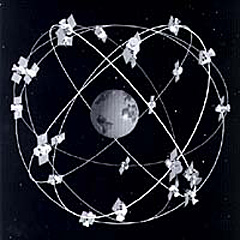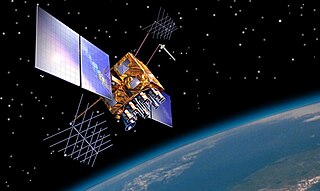
GPS satellite blocks are the various production generations of the Global Positioning System (GPS) used for satellite navigation. The first satellite in the system, Navstar 1, was launched on 22 February 1978. The GPS satellite constellation is operated by the 2nd Space Operations Squadron (2SOPS) of Space Delta 8, United States Space Force.

GPS Block IIF, or GPS IIF is an interim class of GPS (satellite) which were used to bridge the gap between previous Navstar Global Positioning System generations until the GPS Block III satellites became operational. They were built by Boeing, operated by the United States Air Force, and launched by the United Launch Alliance (ULA) using Evolved Expendable Launch Vehicles (EELV). They are the final component of the Block II GPS constellation to be launched. On 5 February 2016, the final Block IIF satellite was successfully launched, completing the series.
USA-71, also known as GPS IIA-2, GPS II-11 and GPS SVN-24, is an American navigation satellite which forms part of the Global Positioning System. It was the second of nineteen Block IIA GPS satellites to be launched.
USA-79, also known as GPS IIA-3, GPS II-12 and GPS SVN-25, was an American navigation satellite which formed part of the Global Positioning System. It was the third of nineteen Block IIA GPS satellites to be launched.
USA-80, also known as GPS IIA-4, GPS II-13 and GPS SVN-28, was an American navigation satellite which formed part of the Global Positioning System. It was the fourth of nineteen Block IIA GPS satellites to be launched.

USA-242, also known as GPS IIF-4, GPS IIF SV-5, Navstar-68 and Vega, is an American navigation satellite which was launched on 15 May 2013 and became operational on 21 June 2013. The fourth Block IIF GPS satellite, it forms part of the Global Positioning System.
USA-85, also known as GPS IIA-7, GPS II-16 and GPS SVN-32, was an American navigation satellite which formed part of the Global Positioning System. It was the seventh of nineteen Block IIA GPS satellites to be launched.
USA-94, also known as GPS IIA-13, GPS II-22 and GPS SVN-35, was an American navigation satellite which formed part of the Global Positioning System. It was the thirteenth of nineteen Block IIA GPS satellites to be launched.
USA-117, also known as GPS IIA-16, GPS II-25 and GPS SVN-33, is an American navigation satellite which forms part of the Global Positioning System. It was the sixteenth of nineteen Block IIA GPS satellites to be launched.
USA-126, also known as GPS IIA-17, GPS II-26 and GPS SVN-40, is an American navigation satellite which forms part of the Global Positioning System. It was the seventeenth of nineteen Block IIA GPS satellites to be launched.

USA-203, also known as GPS IIR-20(M), GPS IIRM-7 and GPS SVN-49, is an American navigation satellite which was intended to become part of the Global Positioning System. It was the sixth of seven Block IIRM satellites to be launched, and the twentieth of twenty one Block IIR satellites overall. It was built by Lockheed Martin, using the AS-4000 satellite bus, and had a mass of 2,032 kilograms (4,480 lb).

USA-232, also known as GPS IIF-2, and GPS SVN-63, is an American navigation satellite which forms part of the Global Positioning System. It was the second of twelve Block IIF satellites to be launched.

USA-239, also known as GPS IIF-3, GPS SVN-65, and Navstar-67 is an American navigation satellite which forms part of the Global Positioning System. It was the third of twelve Block IIF satellites to be launched.

USA-248, also known as GPS IIF-5, GPS SVN-64 and NAVSTAR 69, is an American navigation satellite which forms part of the Global Positioning System. It was the fifth of twelve Block IIF satellites to be launched.

USA-251, also known as GPS IIF-6, GPS SVN-67 and NAVSTAR 70, is an American navigation satellite which forms part of the Global Positioning System. It was the sixth of twelve Block IIF satellites to be launched.

USA-256, also known as GPS IIF-7, GPS SVN-68 and NAVSTAR 71, is an American navigation satellite which forms part of the Global Positioning System. It was the seventh of twelve Block IIF satellites to be launched.

USA-258, also known as GPS IIF-8, GPS SVN-69 and NAVSTAR 72, is an American navigation satellite which forms part of the Global Positioning System. It was the eighth of twelve Block IIF satellites to be launched.

USA-260, also known as GPS IIF-9, GPS SVN-71 and NAVSTAR 73, is an American Satellite navigation which forms part of the Global Positioning System. It was the ninth of twelve Block IIF satellites to be launched.

USA-262, also known as GPS IIF-10, GPS SVN-72 and NAVSTAR 74, is an American navigation satellite which forms part of the Global Positioning System. It was the tenth of twelve Block IIF satellites to be launched.

USA-265, also known as GPS IIF-11, GPS SVN-73 and NAVSTAR 75, is an American navigation satellite which forms part of the Global Positioning System. It was the eleventh of twelve Block IIF satellites to be launched.



